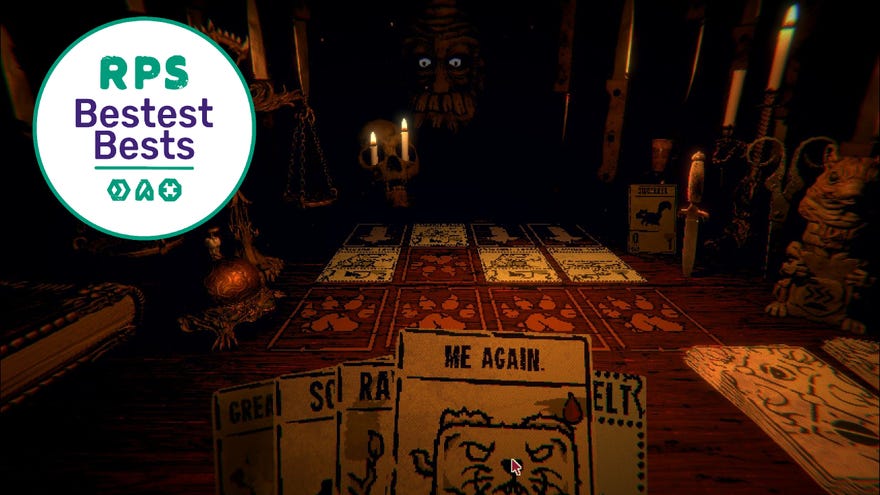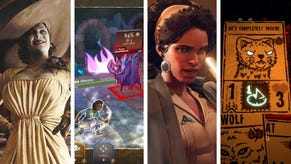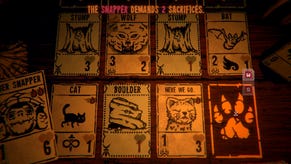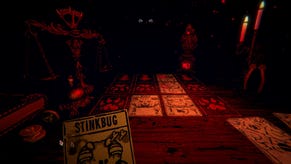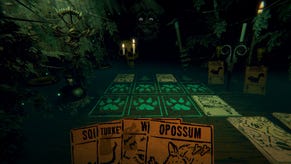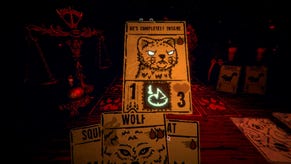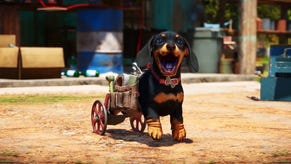Inscryption review: a sinister and excellently crafted card game with a darkly comic underbelly
I've never meta-fiction I didn't like
Be afraid. Inscryption is both a love letter to card games and a twisted, jocular caricature of their numerical excess. It had me grinning ear to ear, sometimes nervously, sometimes with the joy of someone who simply loves thumbing through new cards, even when a rustic antagonist with big hands is reaching for my throat. This is not your average deckbuilder. It's a card game with an escape room built on top, and other sinister secrets buried beneath. The depth of its rabbit hole isn't apparent at first. It starts off as a familiar card battler, if a little darkly themed. You are in a cabin, playing cards against a face shrouded in darkness. It seems like Slay The Spire or Hand Of Fate.
Then the cards start talking.
I won't say much more about the plot itself. This meat is best left unspoiled. If you trust the opinions of a grizzled deck tinkerer, and enjoy comic unease in all its forms, you should simply get stuck in. For anyone else, I'll do my best to tiptoe around the layers of meta-story that unfurl from this game like flakes of skin.
To start, the card game itself. You play wildlife-themed cards against your opponent's own on a four-lane board. Then you ding a little bell to signal the end of your turn. Your Raven will do three damage. His Bullfrog, sitting opposite, has two health. Well done, you've killed the frog. On your next turn, you'll draw a card and keep going. The goal is to do enough damage directly to your opponent to tip a set of scales in your favour. Every point of damage you do to an empty lane will add what looks like a little stone to the scale. They are not stones.
Special rules and abilities are soon introduced. A Mantis can strike in multiple directions, Kingfishers can dive underwater to avoid blows. Skinks leave their tails behind when attacked and escape to the lane next to them. These are all interesting movers and shakers on what sometimes feels like a claustrophobically small board. But the limited space actually means the brawl rarely gets unwieldy or overlong. Decisions matter much more.
"Look closely at the cards in your protagonist's hands and you will see that they are constantly trembling."
But it's those health scales that are the most immediately novel thing. You don't pick away at an opponent's health pool, like in Hearthstone. Instead, the scales tip in both directions, meaning you must win by "positive 5" and stay away from "negative 5" (I won't say what happens when you lose). These scales mean the fight goes back and forth. You lose and gain momentum, deliver killer blows, claw back from a near-loss by being aggressive. One moment you're winning, the next your nemesis has you cornered. It's a compelling twist and the only weakness is that if you figure out a consistent way to deal five points of damage on your first turn, you'll storm through fights with ease. Until a certain moment. Everything in this gloomy cabin is subject to change.
There are other neat angles. The currency to play cards is "blood". Meaning you must sacrifice multiple creatures to play bigger creatures. Squirrels lead to Ants, Ants lead to Wolves, Wolves lead to Bears. Sacrifices must be made. This is only the first example of bloody forfeiture in the game. If Inscryption has a theme, it is "cost". There are other prices you will pay to gain an advantage. Look closely at the cards in your protagonist's hands and you will see that they are constantly trembling.
But the real wobbles come when you get up from the table. This is the "escape room" element I mentioned, with puzzles and riddles and paratextual clues that lead the game into darker and funnier places. Between fights you can get up and move around the cabin in that old 90 degree dungeon crawler way, watched always by two eyes glittering in shadow. There are candles to snuff out, safes to crack. Eventually, you'll find things in the room to help in your card battles.
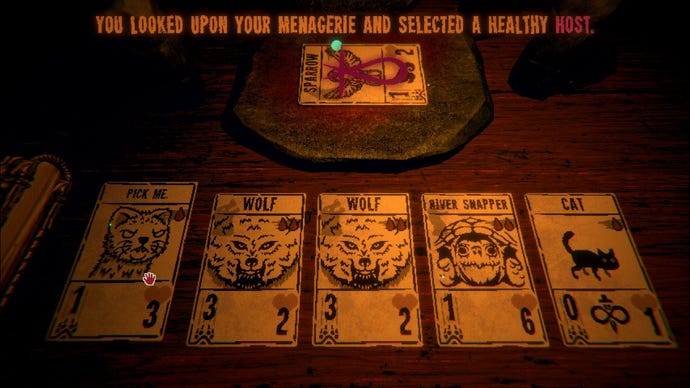
Yet scales tip in both directions. Objects from your card fights, narrated by your macabre opponent, start to bleed into the room. Fungus appears on shelves where it wasn't before. A skull on a cabinet earns itself a gleaming new smile. A rulebook sits to one side, with certain rules blotted out by globs of ink, bringing to mind the inscrutable game of Blaseball and its own censored tome. The whole room stinks of a smiling creepiness, the comedy of rot.
This puzzle aspect sometimes stalls things. After 10 hours of battling my shady antagonist, I knew I was missing something to keep the underbubbling tale going, but couldn't tell what it was. Was the solution in the room, or something I had to perform at the table? There are a few moments like this throughout the game, and while none of them held me up too long, your own patience may strain.
For my own problem, it turns out I didn't make good use of the tools. You see, during your card fights there are also tools to one side. Single-use objects that help turn a match around. A jar containing a sacrificial Squirrel, for example. Scissors that will cut up an opposing card. A pair of pliers that'll tip the scales in your favour. One particular tool needs to be used successfully to progress the story. But I often avoided using this object at all. I hated it. I was not prepared to pay the cost. But we all pay our dues, eventually.
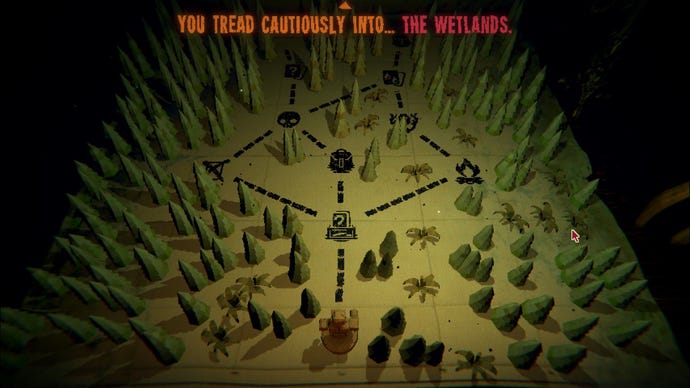
When you do figure out what's hiding beneath these coded floorboards, it's quite the jump. The card game opens up, expands in scale and possibility even as the unusual frame around it contracts to breaking point. There is a wacky amount of depth to it. Some of the card engineering you can do later is breathtakingly overpowered, downright broken from a balance perspective, either by intention or as a result of increasing complexity. If the cards contained here existed in reality as part of a TCG, they would need to be expunged. No YouTuber should ever be exposed to this many overlapping strats and combos. At one point I discovered a way to upgrade a particular lizard in strength and health, theoretically infinitely, and the only reason I did not do this is because infinity takes too long.
There are plenty of other things that make this a superbly designed card game, independent of its sinister framing device and whirligig story that tumbles ever-deeper into the realm of the digital uncanny. There are totems that can make all your harmless Squirrels stink so much it nullifies the attacks of opposing animals. There are ominous and cool ways of creating entirely new cards. There are bosses that consistently pull the pelt rug out from under you, changing rules mid-game like fickle children. Fairness is something you must find in the trinkets and puzzles of the cabin and, later, in other places.

I hope I've convinced you. Inscryption is the work of a dark jester. It begins as a horror game in the vein of playing chess with Death. But soon becomes an eccentric dive into video game occultism. I have laughed to the point of tears at each tumble that took me further into its innards, and felt a twinge of sadness at its close. This is a game that includes the phrase "The inhabited corpse maggots joined your menagerie". I don't know how else to sell it to you. It continues for a surprising length down its twisting path, long past the point that games would have happily bowed out and shown you the credits. It has the flavour of cursed internet artefacts like creepy pasta text dumps or Brian David Gilbert's more instructive videos. Surreal tales that are both funny and unsettling. Funsettling.
That's what you're getting into here. A finely crafted card game sealed in a meta-narrative wrapper that you sometimes have to tear off when it snags, but when that wrapping falls away, Inscryption reveals itself as a rare shiny. A clever game without taking itself too seriously. Metafiction always runs the risk of being pompous and showy. By contrast, this is an impish game, trollish even, repeatedly reinventing its own rules. A beautifully cursed creation.
